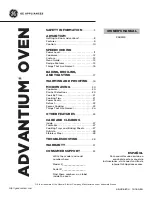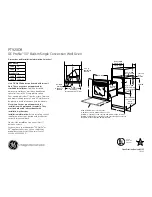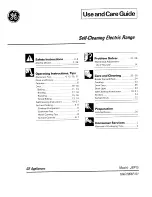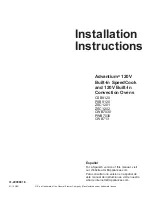
15
OPERATION
EN
G
LI
SH
plastic bags only for short cooking times. Do
not use them when cooking food for long
periods or at high power levels, as the hot food
will eventually warp or melt the plastic.
-
Plastic wrap (as a cover)
: Lay the plastic wrap
loosely over the dish and press it to the sides.
Vent plastic wrap by turning back one edge
slightly to allow excess steam to escape. The
dish should be deep enough so that the plastic
wrap will not touch the food. As the food heats
it may melt the plastic wrap wherever the wrap
touches the food.
-
Plastic Cooking Bags
: Provided they are
specially made for cooking, cooking bags are
microwave safe. Remember to make a slit in
the bag so that steam can escape. Never use
ordinary plastic bags for cooking in the
microwave oven, as they will melt and rupture.
-
Plastic Microwave Cookware
: A variety of
shapes and sizes of microwave cookware are
available. You may be able to use items you
already have on hand rather than investing in
new kitchen equipment.
•
Paper
- Use paper towels, waxed paper, paper
napkins, and paper plates with no metal rims
or design. Look for the manufacturer’s label
for use in the microwave oven.
- Paper plates and containers are convenient
and safe to use in the microwave oven,
provided that the cooking time is short and
foods to be cooked are low in fat and
moisture. Paper towels are also very useful for
wrapping foods and for lining baking trays in
which greasy foods such as bacon are cooked.
- Avoid colored paper products as the color may
run. Do not use recycled paper products in the
microwave oven. They may contain impurities
which could cause arcing or fires when used in
the microwave.
•
Tableware
- Do not put plates with painted decoration in
the oven, as the paint may contain metal and
cause arcing.
Microwave-Unsafe Cookware
•
Metal Containers/Metal Decoration
- Never use metal or metal-rimmed cookware in
the microwave oven.
- Microwaves cannot penetrate metal. They will
bounce off any metal object in the oven and
cause arcing, an alarming phenomenon that
resembles lightning.
- Metal shields the food from microwave energy
and produces uneven cooking. Also avoid
metal skewers, thermometers, foil trays,
metal-rimmed or metal-banded dinnerware,
casserole dishes, etc. The metal rim interferes
with normal cooking and may damage the
oven.
•
Aluminum Foil
- Avoid large sheets of aluminum foil because
they hinder cooking and may cause harmful
arcing.
- Use small pieces of foil to shield poultry legs
and wings.
- Keep ALL aluminum foil at least 1" (2.54 cm)
from the side walls and door of the oven.
•
Wood
- Wood bowls and boards will dry out and may
split or crack when you use them in the
microwave oven.
- Baskets react in the same way.
•
Tightly Covered Cookware
- Be sure to leave openings for steam to escape
from covered containers.
- Pierce plastic pouches of vegetables or other
food items before cooking.
- Tightly closed pouches could explode.
•
Brown Paper
- Avoid using brown paper bags.
- They absorb too much heat and could burn.
•
Flawed or Chipped Cookware
:
- Any container that is cracked, flawed, or
chipped may break in the oven.
•
Metal Twist Ties
- Remove metal twist ties from plastic or paper
bags.
- They become hot and could cause a fire.
Cooking Tips
Carefully monitor the food in the microwave oven
while it is cooking. Directions given in recipes to
elevate, stir, etc., are the minimum steps
recommended. If food is overcooked (dry),
undercooked, or unevenly cooked, make
adjustments before or during cooking to correct
the problem.
•
Overcooked or Dry Food
-
Sprinkling
: Sprinkle low-moisture foods such
as roasts and vegetables with water before
cooking, or cover them to retain moisture.
us_main.book.book Page 15 Friday, September 10, 2021 11:51 AM
















































